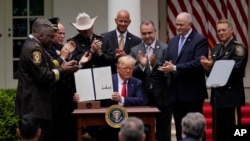President Donald Trump signed an executive order Tuesday aimed at curbing police brutality by directing federal dollars to those police departments that meet certain credentialing standards on the use of force. The executive action also makes it harder for those officers with a troubled history from getting hired by other departments.
Congress is also moving toward passing policing bills, but Trump was anxious to put his own stamp on the issue with a Rose Garden press conference in which he was flanked by representatives from the nation's leading law enforcement groups.
Here's a look at some of the topics in the order:
What are the most important provisions?
The executive order would give police departments a financial incentive to adopt best practices and encourage programs in which social workers join police when they respond to nonviolent calls involving mental health, addiction and homeless issues.
The president's executive order also requires the attorney general to create a database tracking terminations, criminal convictions and civil judgments against law enforcement officers for excessive use-of-force. It encourages participation by providing certain grants only to those agencies that submit the required information.
Why track officer misconduct?
Many officers who wind up involved in a fatal incident have a long history of complaints made against them by the public, including Derek Chauvin, the white Minneapolis police officer who has been charged with murder in the death of George Floyd. Chauvin had at least a dozen complaints made against him, according to records.
But those records are often not made public, making it difficult to know if officers have a track record. And some police departments do a bad job of keeping track of misconduct claims, since not all are substantiated for a variety of reasons, and police reform groups say it's a missed opportunity to identify and correct problem behaviors before it turns fatal.
What will a national database do?
A national database would force some departments into more transparency and accountability, but like other national clearinghouses, it depends on the locality's willingness to participate.
Are chokeholds banned?
Trump said he was banning chokeholds, but that's not the case. Rather, he's encouraging such bans through financial incentives.
Chokeholds have become a symbol of police brutality again following the death of Floyd. They are a potentially tactical maneuver in which an officer cuts off air to a person's neck. The officer involved in the death of Eric Garner was accused of using one, but has maintained he was employing a legal takedown maneuver called the seatbelt which is similar but doesn't block air. But chokeholds are already largely banned by many departments around the country.
Can the administration set conditions on funding?
That could be a matter of legal dispute.
There have been a number of lawsuits brought in the past against the Trump administration for attempting to condition the same law enforcement funding on specific policies.
A similar situation happened in 2017 when the Justice Department said it would withhold grant money from so-called sanctuary cities and states until they gave federal immigration authorities access to jails and provide advance notice when someone in the country illegally is about to be released.
Courts around the country have been divided on the issue.
A federal judge in Los Angeles ruled last February to block the Trump administration from imposing conditions that police departments cooperate with immigration authorities to receive law enforcement grants. But earlier this year, a federal appeals court in New York said the administration can withhold millions of dollars in law enforcement grants to force states to cooperate with immigration enforcement. That decision conflicted with three other federal appeals courts.
How would certification work?
The executive order instructs the Justice Department to push local police departments to be certified by a "reputable independent credentialing body." Under the order, the Justice Department would ensure a department could only be credentialed if its use-of-force policies adhered to federal, state, and local laws.
An organization called the Commission on Accreditation for Law Enforcement Agencies already credentials police departments. It lists more than 1,000 departments it has credentialed, out of roughly 18,000 nationwide.
Matthew Hickman, a professor and criminal justice expert at Seattle University, said there's no definitive research proving credentialed agencies better serve the public.
"It's good for the public, arguably, to know that their agency has gone through a professional accreditation process," he said. "It says something about the commitment to best practices."









